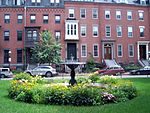Boston Center for the Arts
1970 establishments in MassachusettsBuildings and structures in BostonCultural history of BostonCulture of BostonSouth End, Boston ... and 1 more
Theatres in Boston
The Boston Center for the Arts (BCA) is a 501(c) nonprofit visual and performing arts complex in the South End neighborhood of Boston, Massachusetts. The BCA houses several performance and rehearsal spaces, restaurants, a gallery, the headquarters of the Boston Ballet, the Community Music Center of Boston and several other arts organizations. The BCA also serves as home to four Resident Theater Companies and a number of artists. The BCA's main building, the Cyclorama, is on the National Register of Historic Places. Boston Ballet's headquarters was designed in 1991 by architect Graham Gund.
Excerpt from the Wikipedia article Boston Center for the Arts (License: CC BY-SA 3.0, Authors).Boston Center for the Arts
Tremont Street, Boston South End
Geographical coordinates (GPS) Address Nearby Places Show on map
Geographical coordinates (GPS)
| Latitude | Longitude |
|---|---|
| N 42.3447 ° | E -71.0714 ° |
Address
Cyclorama Building
Tremont Street 539
02116 Boston, South End
Massachusetts, United States
Open on Google Maps





